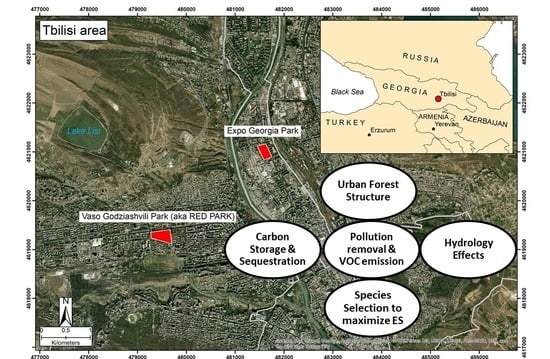Ecosystem Services Provided by Urban Forests in the Southern Caucasus Region: A Modeling Study in Tbilisi, Georgia
Abstract
:1. Introduction
2. Materials and Methods
2.1. Study Area
2.2. Tree Inventory
2.3. Model Settings
3. Results
3.1. Weather and Pollution Data
3.2. Urban Forests
3.3. Carbon Storage and Sequestration
3.4. Pollution Removal
3.5. Hydrology Effects
3.6. Selected Species Performance for Urban Reforestation in Tbilisi
4. Discussion
4.1. Urban Forest Structure and Ecosystem Services Provision
4.2. Tree Measurements and Model Uncertainties
4.3. Urban Green Planning in Tbilisi and Future Perspectives
4.4. The Value and Role of Urban Forests
5. Conclusions
Supplementary Materials
Author Contributions
Funding
Institutional Review Board Statement
Informed Consent Statement
Data Availability Statement
Acknowledgments
Conflicts of Interest
References
- Beatley, T. Biophilic Urbanism: Inviting Nature Back to Our Communities and Into Our Lives. William Mary Environ. Law Policy Rev. 2009, 34, 209. [Google Scholar]
- Unterweger, P.; Schrode, N.; Betz, O. Urban Nature: Perception and Acceptance of Alternative Green Space Management and the Change of Awareness after Provision of Environmental Information. A Chance for Biodiversity Protection. Urban Sci. 2017, 1, 24. [Google Scholar] [CrossRef] [Green Version]
- Liu, Z.; He, C.; Zhou, Y.; Wu, J. How much of the world’s land has been urbanized, really? A hierarchical framework for avoiding confusion. Landsc. Ecol. 2014, 29, 763–771. [Google Scholar] [CrossRef]
- Gómez-Baggethun, E.; Gren, Å.; Barton, D.N.; Langemeyer, J.; McPhearson, T.; O’Farrell, P.; Andersson, E.; Hamstead, Z.; Kremer, P. Urban Ecosystem Services. In Urbanization, Biodiversity and Ecosystem Services: Challenges and Opportunities: A Global Assessment; Elmqvist, T., Fragkias, M., Goodness, J., Güneralp, B., Marcotullio, P.J., McDonald, R.I., Parnell, S., Schewenius, M., Sendstad, M., Seto, K.C., et al., Eds.; Springer: Dordrecht, The Netherlands, 2013; pp. 175–251. ISBN 978-94-007-7088-1. [Google Scholar]
- UN-Habitat. World Cities Report 2020: The Value of Sustainable Urbanization; UN-Habitat: Nairobi, Kenya, 2020. [Google Scholar]
- Kampelmann, S. Urban Ecosystem Services: Literature Review and Operationalization for the Case of Brussels; Université Libre de Bruxelles: Brussels, Belgium, 2014. [Google Scholar]
- Breuste, J.; Schnellinger, J.; Qureshi, S.; Faggi, A. Urban Ecosystem services on the local level: Urban green spaces as providers. Ekológia (Bratisl.) 2013, 32, 290–304. [Google Scholar] [CrossRef] [Green Version]
- Shaddick, G.; Thomas, M.L.; Mudu, P.; Ruggeri, G.; Gumy, S. Half the world’s population are exposed to increasing air pollution. NPJ Clim. Atmos. Sci. 2020, 3, 1–5. [Google Scholar] [CrossRef]
- McCarthy, M.P.; Best, M.J.; Betts, R.A. Climate change in cities due to global warming and urban effects. Geophys. Res. Lett. 2010, 37, 1–5. [Google Scholar] [CrossRef] [Green Version]
- Simpson, G.B.; Jewitt, G.P.W. The development of the water-energy-food nexus as a framework for achieving resource security: A review. Front. Environ. Sci. 2019, 7, 8. [Google Scholar] [CrossRef] [Green Version]
- Nowak, D.J.; Crane, D.E. Carbon storage and sequestration by urban trees in the USA. Environ. Pollut. 2002, 116, 381–389. [Google Scholar] [CrossRef]
- Santamouris, M.; Osmond, P. Increasing Green Infrastructure in Cities: Impact on Ambient Temperature, Air Quality and Heat-Related Mortality and Morbidity. Buildings 2020, 10, 233. [Google Scholar] [CrossRef]
- Rahman, M.A.; Stratopoulos, L.M.F.; Moser-Reischl, A.; Zölch, T.; Häberle, K.H.; Rötzer, T.; Pretzsch, H.; Pauleit, S. Traits of trees for cooling urban heat islands: A meta-analysis. Build. Environ. 2020, 170, 106606. [Google Scholar] [CrossRef]
- Grey, V.; Livesley, S.J.; Fletcher, T.D.; Szota, C. Establishing street trees in stormwater control measures can double tree growth when extended waterlogging is avoided. Landsc. Urban Plan. 2018, 178, 122–129. [Google Scholar] [CrossRef]
- Coville, R.; Endreny, T.; Nowak, D.J. Modeling the Impact of Urban Trees on Hydrology. In Forest-Water Interactions; Levia, D.F., Carlyle-Moses, D.E., Iida, S., Michalzik, B., Nanko, K., Tischer, A., Eds.; Springer International Publishing: Cham, Switzerland, 2020; pp. 459–487. ISBN 978-3-030-26086-6. [Google Scholar]
- Lama, G.F.C.; Rillo Migliorini Giovannini, M.; Errico, A.; Mirzaei, S.; Padulano, R.; Chirico, G.B.; Preti, F. Hydraulic Efficiency of Green-Blue Flood Control Scenarios for Vegetated Rivers: 1D and 2D Unsteady Simulations. Water 2021, 13, 2620. [Google Scholar] [CrossRef]
- Dwyer, J.F.; Nowak, D.J.; Noble, M.H. Sustaining Urban Forests. J. Arboric. 2003, 29, 49–55. [Google Scholar]
- Biocca, M.; Gallo, P.; Di Loreto, G.; Imperi, G.; Pochi, D.; Fornaciari, L. Noise attenuation provided by hedges. J. Agric. Eng. 2019, 50, 113–119. [Google Scholar] [CrossRef]
- Andersson, E.; Tengö, M.; McPhearson, T.; Kremer, P. Cultural ecosystem services as a gateway for improving urban sustainability. Ecosyst. Serv. 2015, 12, 165–168. [Google Scholar] [CrossRef]
- Higgins, S.L.; Thomas, F.; Goldsmith, B.; Brooks, S.J.; Hassall, C.; Harlow, J.; Stone, D.; Völker, S.; White, P. Urban freshwaters, biodiversity, and human health and well-being: Setting an interdisciplinary research agenda. WIREs Water 2019, 6, e1339. [Google Scholar] [CrossRef]
- Wang, B.; Zhang, Q.; Cui, F. Scientific research on ecosystem services and human well-being: A bibliometric analysis. Ecol. Indic. 2021, 125, 107449. [Google Scholar] [CrossRef]
- Krajter Ostoić, S.; Salbitano, F.; Borelli, S.; Verlič, A. Urban forest research in the Mediterranean: A systematic review. Urban For. Urban Green. 2018, 31, 185–196. [Google Scholar] [CrossRef]
- FAO. Global Forest Resources Assessment 2020: Main Report; FAO: Rome, Italy, 2020; ISBN 978-92-5-132974-0. [Google Scholar]
- Ministry of Environmental Protection and Agriculture of Georgia. Third National Environmental Action Programme of Georgia 2017–2021; Ministry of Environmental Protection and Agriculture of Georgia: Tbilisi, Georgia, 2018.
- Salukvadze, J.; Golubchikov, O. City as a geopolitics: Tbilisi, Georgia—A globalizing metropolis in a turbulent region. Cities 2016, 52, 39–54. [Google Scholar] [CrossRef] [Green Version]
- Tbilisi City Hall. Tbilisi in Figures 2018; Tbilisi City Hall: Tbilisi, Georgia, 2018.
- Gadrani, L.; Lominadze, G.; Tsitsagi, M. F assessment of landuse/landcover (LULC) change of Tbilisi and surrounding area using remote sensing (RS) and GIS. Ann. Agrar. Sci. 2018, 16, 163–169. [Google Scholar] [CrossRef]
- Ministry of Environmental Protection and Agriculture of Georgia. Georgia’s Second Biennial Update Report under the United Nations Framework Convention on Climate Change; Ministry of Environmental Protection and Agriculture of Georgia: Tbilisi, Georgia, 2019.
- National Accounts Department of National Statistics Office of Georgia. National Accounts of Georgia 2019 (Statistical Publication); National Accounts Department of National Statistics Office of Georgia: Tbilisi, Georgia, 2021.
- Parliament of Georgia. Thematic Inquiry Report of the Environment Protection and Natural Resources Committee of the Parliament of Georgia on Air Quality in Tbilisi; Parliament of Georgia: Tbilisi, Georgia, 2019.
- Tbilisi City Hall List of Selected Tree Species. Available online: https://tbilisi.gov.ge/img/original/2018/3/20/05.14.147-Kheebis-Sia.pdf (accessed on 21 May 2021).
- Lin, J.; Kroll, C.N.; Nowak, D.J.; Greenfield, E.J. A review of urban forest modeling: Implications for management and future research. Urban For. Urban Green. 2019, 43, 126366. [Google Scholar] [CrossRef]
- National Statistics Office of Georgia Population as of 1 January by Regions and Self-Governed Units. Available online: https://www.geostat.ge/en/modules/categories/41/population (accessed on 10 May 2021).
- Gaprindashvili, G.; Gaprindashvili, M.; Tsereteli, E. Natural Disaster in Tbilisi City (Riv. Vere Basin) in the Year 2015. Int. J. Geosci. 2016, 7, 1074–1087. [Google Scholar] [CrossRef] [Green Version]
- I-Tree. I-Tree Eco Field Guide v.6; I-Tree: 2020. Available online: https://www.itreetools.org/documents/274/EcoV6.FieldManual.2021.10.06.pdf (accessed on 21 May 2021).
- Nowak, D.J.; Crane, D.E.; Stevens, J.C.; Hoehn, R.E.; Walton, J.T.; Bond, J. A Ground-Based Method of Assessing Urban Forest Structure and Ecosystem Services. Arboric. Urban For. 2008, 34, 347–358. [Google Scholar]
- Nowak, D.J. Understanding i-Tree: Summary of Programs and Methods; US Department of Agriculture, Forest Service, Northern Research Station: Madison, WI, USA, 2020.
- Hirabayashi, S.; Kroll, C.N.; Nowak, D.J. Development of a distributed air pollutant dry deposition modeling framework. Environ. Pollut. 2012, 171, 9–17. [Google Scholar] [CrossRef] [PubMed]
- Nowak, D.J.; Hirabayashi, S.; Bodine, A.; Hoehn, R. Modeled PM2.5 removal by trees in ten U.S. cities and associated health effects. Environ. Pollut. 2013, 178, 395–402. [Google Scholar] [CrossRef]
- Hirabayashi, S. i-Tree Eco Precipitation Interception Model Descriptions; US Department of Agriculture Forest Service: Washington, DC, USA, 2013.
- Pace, R.; Biber, P.; Pretzsch, H.; Grote, R. Modeling ecosystem services for park trees: Sensitivity of i-tree eco simulations to light exposure and tree species classification. Forests 2018, 9, 89. [Google Scholar] [CrossRef] [Green Version]
- Selmi, W.; Weber, C.; Rivière, E.; Blond, N.; Mehdi, L.; Nowak, D. Air pollution removal by trees in public green spaces in Strasbourg city, France. Urban For. Urban Green. 2016, 17, 192–201. [Google Scholar] [CrossRef] [Green Version]
- Kenton, R.; Sacre, K.; Goodenough, J.; Doick, K. Valuing London’s Urban Forest; Treeconomics: London, UK, 2015; ISBN 9780957137110. [Google Scholar]
- Nowak, D.J.; Crane, D.E.; Stevens, J.C. Air pollution removal by urban trees and shrubs in the United States. Urban For. Urban Green. 2006, 4, 115–123. [Google Scholar] [CrossRef]
- Fitzky, A.C.; Sandén, H.; Karl, T.; Fares, S.; Calfapietra, C.; Grote, R.; Saunier, A.; Rewald, B. The Interplay Between Ozone and Urban Vegetation—BVOC Emissions, Ozone Deposition, and Tree Ecophysiology. Front. For. Glob. Chang. 2019, 2, 1–17. [Google Scholar] [CrossRef]
- Rötzer, T.; Rahman, M.A.; Moser-Reischl, A.; Pauleit, S.; Pretzsch, H. Process based simulation of tree growth and ecosystem services of urban trees under present and future climate conditions. Sci. Total Environ. 2019, 676, 651–664. [Google Scholar] [CrossRef] [PubMed]
- Rahman, M.A.; Moser, A.; Rötzer, T.; Pauleit, S. Within canopy temperature differences and cooling ability of Tilia cordata trees grown in urban conditions. Build. Environ. 2017, 114, 118–128. [Google Scholar] [CrossRef]
- Berland, A.; Shiflett, S.A.; Shuster, W.D.; Garmestani, A.S.; Goddard, H.C.; Herrmann, D.L.; Hopton, M.E. The role of trees in urban stormwater management. Landsc. Urban Plan. 2017, 162, 167–177. [Google Scholar] [CrossRef] [Green Version]
- Tan, X.; Hirabayashi, S.; Shibata, S. Estimation of ecosystem services provided by street trees in Kyoto, Japan. Forests 2021, 12, 311. [Google Scholar] [CrossRef]
- Pace, R.; Masini, E.; Giuliarelli, D.; Biagiola, L.; Tomao, A.; Guidolotti, G.; Agrimi, M.; Portoghesi, L.; De Angelis, P.; Calfapietra, C. Tree measurements in the urban environment: Insights from traditional and digital field instruments to smartphone applications. Arboric. Urban For. 2021, accepted. [Google Scholar]
- Nowak, D.J.; Walton, J.T.; Stevens, J.C.; Crane, D.E.; Hoehn, R.E. Effect of plot and sample size on timing and precision of urban forest assessments. Arboric. Urban For. 2008, 34, 386–390. [Google Scholar]
- Lin, B.J.; Kroll, C.N.; Nowak, D.J. Ecosystem service-based sensitivity analyses of i-Tree Eco. Arboric. Urban For. 2020, 46, 287–306. [Google Scholar] [CrossRef]
- Lin, J.; Kroll, C.N.; Nowak, D.J. An uncertainty framework for i-Tree eco: A comparative study of 15 cities across the United States. Urban For. Urban Green. 2021, 60, 127062. [Google Scholar] [CrossRef]
- Morani, A.; Nowak, D.; Hirabayashi, S.; Guidolotti, G.; Medori, M.; Muzzini, V.; Fares, S.; Scarascia Mugnozza, G.; Calfapietra, C. Comparing i-Tree modeled ozone deposition with field measurements in a periurban Mediterranean forest. Environ. Pollut. 2014, 195, 202–209. [Google Scholar] [CrossRef]
- Pace, R.; De Fino, F.; Rahman, M.A.; Pauleit, S.; Nowak, D.J.; Grote, R. A single tree model to consistently simulate cooling, shading, and pollution uptake of urban trees. Int. J. Biometeorol. 2021, 65, 277–289. [Google Scholar] [CrossRef]
- Pace, R.; Guidolotti, G.; Baldacchini, C.; Pallozzi, E.; Grote, R.; Nowak, D.J.; Calfapietra, C. Comparing i-Tree Eco Estimates of Particulate Matter Deposition with Leaf and Canopy Measurements in an Urban Mediterranean Holm Oak Forest. Environ. Sci. Technol. 2021, 55, 6613–6622. [Google Scholar] [CrossRef]
- Moser, A.; Rötzer, T.; Pauleit, S.; Pretzsch, H. The urban environment can modify drought stress of small-leaved lime (Tilia cordata Mill.) and black locust (Robinia pseudoacacia L.). Forests 2016, 7, 71. [Google Scholar] [CrossRef] [Green Version]
- Grantz, D.A.; Gunn, S.; Vu, H.B. O3 impacts on plant development: A meta-analysis of root/shoot allocation and growth. Plant Cell Environ. 2006, 29, 1193–1209. [Google Scholar] [CrossRef]
- McHale, M.R.; Burke, I.C.; Lefsky, M.A.; Peper, P.J.; McPherson, E.G. Urban forest biomass estimates: Is it important to use allometric relationships developed specifically for urban trees? Urban Ecosyst. 2009, 12, 95–113. [Google Scholar] [CrossRef]
- Sinha, P.; Coville, R.C.; Hirabayashi, S.; Lim, B.; Endreny, T.A.; Nowak, D.J. Modeling lives saved from extreme heat by urban tree cover✰. Ecol. Modell. 2021, 449, 109553. [Google Scholar] [CrossRef]
- Nowak, D.J.; Coville, R.; Endreny, T.; Abdi, R.; Van Stan, J.T., II. Valuing Urban Tree Impacts on Precipitation Partitioning. In Precipitation Partitioning by Vegetation: A Global Synthesis; Van Stan John, T., II, Gutmann, E., Friesen, J., Eds.; Springer International Publishing: Cham, Switzerland, 2020; pp. 253–268. ISBN 978-3-030-29702-2. [Google Scholar]
- Pretzsch, H.; Moser-Reischl, A.; Rahman, M.A.; Pauleit, S.; Rötzer, T. Towards sustainable management of the stock and ecosystem services of urban trees. From theory to model and application. Trees—Struct. Funct. 2021. [Google Scholar] [CrossRef]
- Pace, R.; Grote, R. Deposition and Resuspension Mechanisms Into and From Tree Canopies: A Study Modeling Particle Removal of Conifers and Broadleaves in Different Cities. Front. For. Glob. Chang. 2020, 3, 26. [Google Scholar] [CrossRef] [Green Version]
- Churkina, G.; Grote, R.; Butler, T.M.; Lawrence, M. Natural selection? Picking the right trees for urban greening. Environ. Sci. Policy 2015, 47, 12–17. [Google Scholar] [CrossRef] [Green Version]
- Sicard, P.; Agathokleous, E.; Araminiene, V.; Carrari, E.; Hoshika, Y.; De Marco, A.; Paoletti, E. Should we see urban trees as effective solutions to reduce increasing ozone levels in cities? Environ. Pollut. 2018, 243, 163–176. [Google Scholar] [CrossRef]
- Calfapietra, C.; Fares, S.; Manes, F.; Morani, A.; Sgrigna, G.; Loreto, F. Role of Biogenic Volatile Organic Compounds (BVOC) emitted by urban trees on ozone concentration in cities: A review. Environ. Pollut. 2013, 183, 71–80. [Google Scholar] [CrossRef] [PubMed]
- Barwise, Y.; Kumar, P. Designing vegetation barriers for urban air pollution abatement: A practical review for appropriate plant species selection. NPJ Clim. Atmos. Sci. 2020, 3, 1–19. [Google Scholar] [CrossRef] [Green Version]
- Turkelboom, F.; Leone, M.; Jacobs, S.; Kelemen, E.; García-Llorente, M.; Baró, F.; Termansen, M.; Barton, D.N.; Berry, P.; Stange, E.; et al. When we cannot have it all: Ecosystem services trade-offs in the context of spatial planning. Ecosyst. Serv. 2018, 29, 566–578. [Google Scholar] [CrossRef]
- Badiu, D.L.; IojǍ, C.I.; PǍtroescu, M.; Breuste, J.; Artmann, M.; NiţǍ, M.R.; GrǍdinaru, S.R.; Hossu, C.A.; Onose, D.A. Is urban green space per capita a valuable target to achieve cities’ sustainability goals? Romania as a case study. Ecol. Indic. 2016, 70, 53–66. [Google Scholar] [CrossRef]
- Pataki, D.E.; Alberti, M.; Cadenasso, M.L.; Felson, A.J.; McDonnell, M.J.; Pincetl, S.; Pouyat, R.V.; Setälä, H.; Whitlow, T.H. The Benefits and Limits of Urban Tree Planting for Environmental and Human Health. Front. Ecol. Evol. 2021, 9, 155. [Google Scholar] [CrossRef]
- Roman, L.A.; Conway, T.M.; Eisenman, T.S.; Koeser, A.K.; Ordóñez Barona, C.; Locke, D.H.; Jenerette, G.D.; Östberg, J.; Vogt, J. Beyond ‘trees are good’: Disservices, management costs, and tradeoffs in urban forestry. Ambio 2021, 50, 615–630. [Google Scholar] [CrossRef] [PubMed]
- Borowski, P.F.; Patuk, I. Environmental, social and economic factors in sustainable development with food, energy and eco-space aspect security. Present Environ. Sustain. Dev. 2021, 15, 153–169. [Google Scholar] [CrossRef]
- Lafortezza, R.; Davies, C.; Sanesi, G.; Konijnendijk, C.C. Green infrastructure as a tool to support spatial planning in European urban regions. IForest 2013, 6, 102–108. [Google Scholar] [CrossRef] [Green Version]
- Carrus, G.; Scopelliti, M.; Lafortezza, R.; Colangelo, G.; Ferrini, F.; Salbitano, F.; Agrimi, M.; Portoghesi, L.; Semenzato, P.; Sanesi, G. Go greener, feel better? The positive effects of biodiversity on the well-being of individuals visiting urban and peri-urban green areas. Landsc. Urban Plan. 2015, 134, 221–228. [Google Scholar] [CrossRef]
- Yessoufou, K.; Sithole, M.; Elansary, H.O. Effects of urban green spaces on human perceived health improvements: Provision of green spaces is not enough but how people use them matters. PLoS ONE 2020, 15, e0239314. [Google Scholar] [CrossRef]
- Selmi, W.; Selmi, S.; Teller, J.; Weber, C.; Rivière, E.; Nowak, D.J. Prioritizing the provision of urban ecosystem services in deprived areas, a question of environmental justice. Ambio 2021, 50, 1035–1046. [Google Scholar] [CrossRef] [PubMed]
- Nowak, D.J. Assessing the benefits and economic values of trees. In Routledge Handbook of Urban Forestry; Ferrini, F., van den Bosch, C.C.K., Fini, A., Eds.; Routledge: London, UK, 2017; pp. 152–163. [Google Scholar]
- Roy, S.; Byrne, J.; Pickering, C. A systematic quantitative review of urban tree benefits, costs, and assessment methods across cities in different climatic zones. Urban For. Urban Green. 2012, 11, 351–363. [Google Scholar] [CrossRef] [Green Version]
- Vogt, J.; Hauer, R.J.; Fischer, B.C. The costs of maintaining and not maintaining the urban forest: A review of the urban forestry and arboriculture literature. Arboric. Urban For. 2015, 41, 293–323. [Google Scholar]
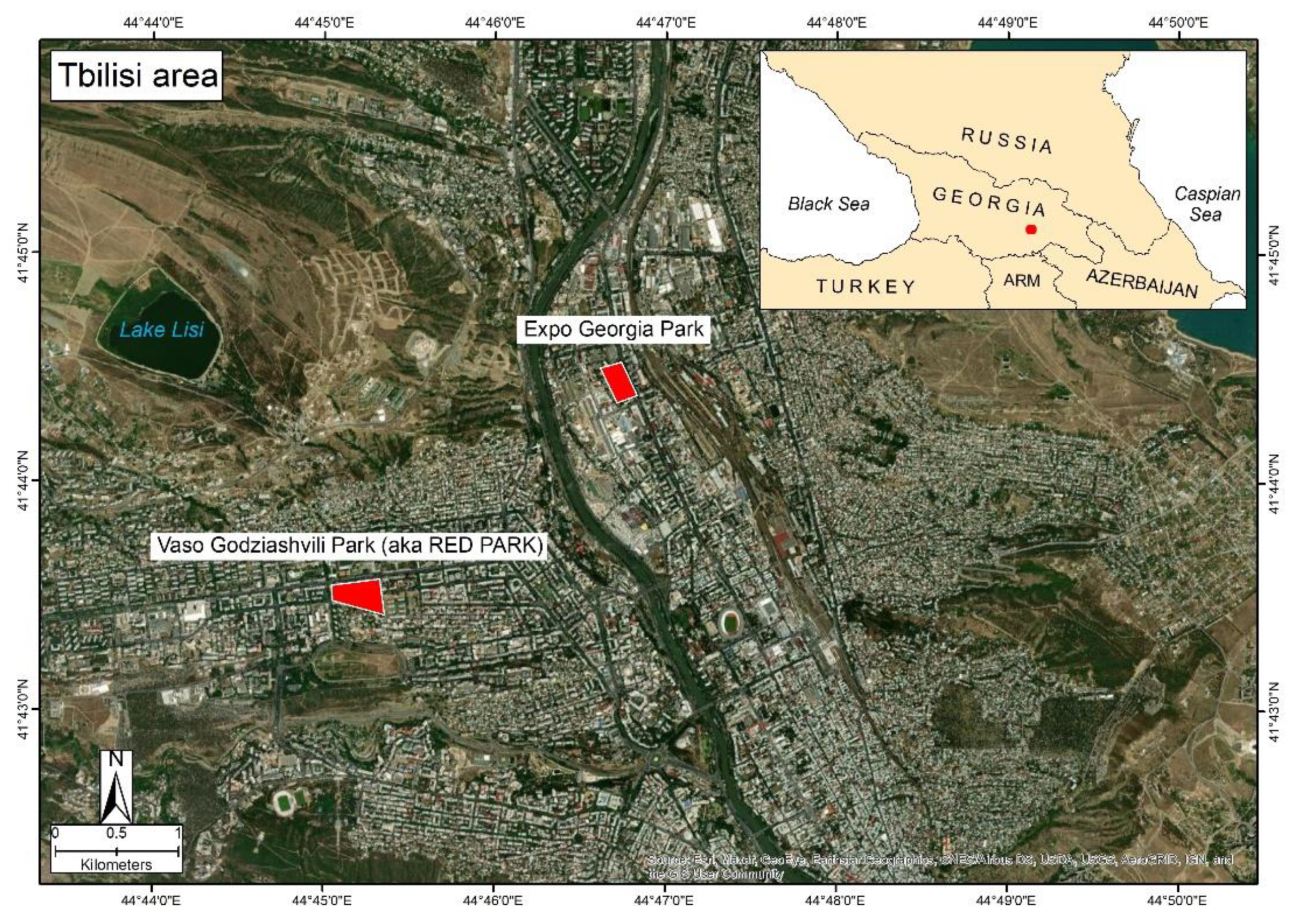

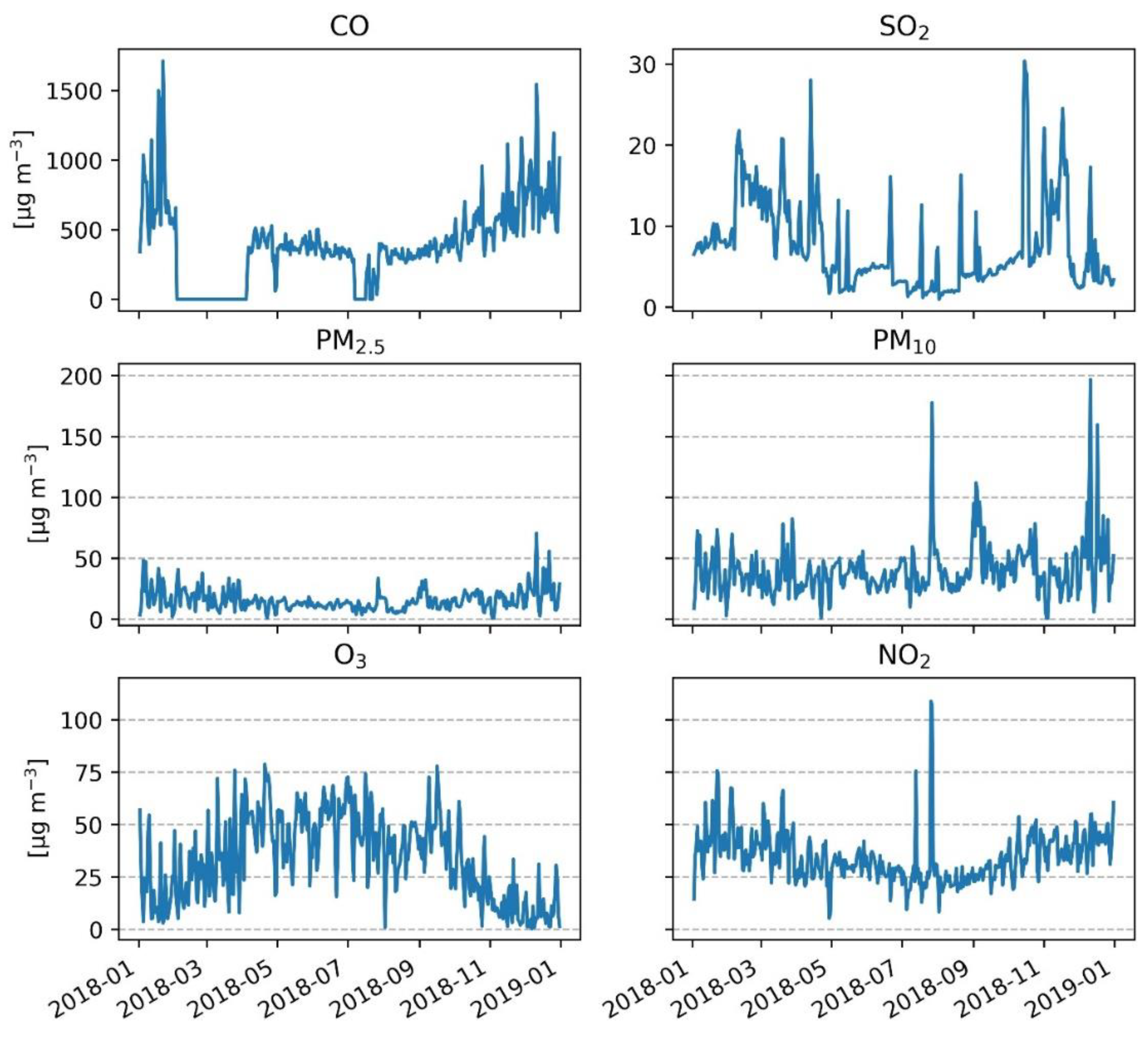
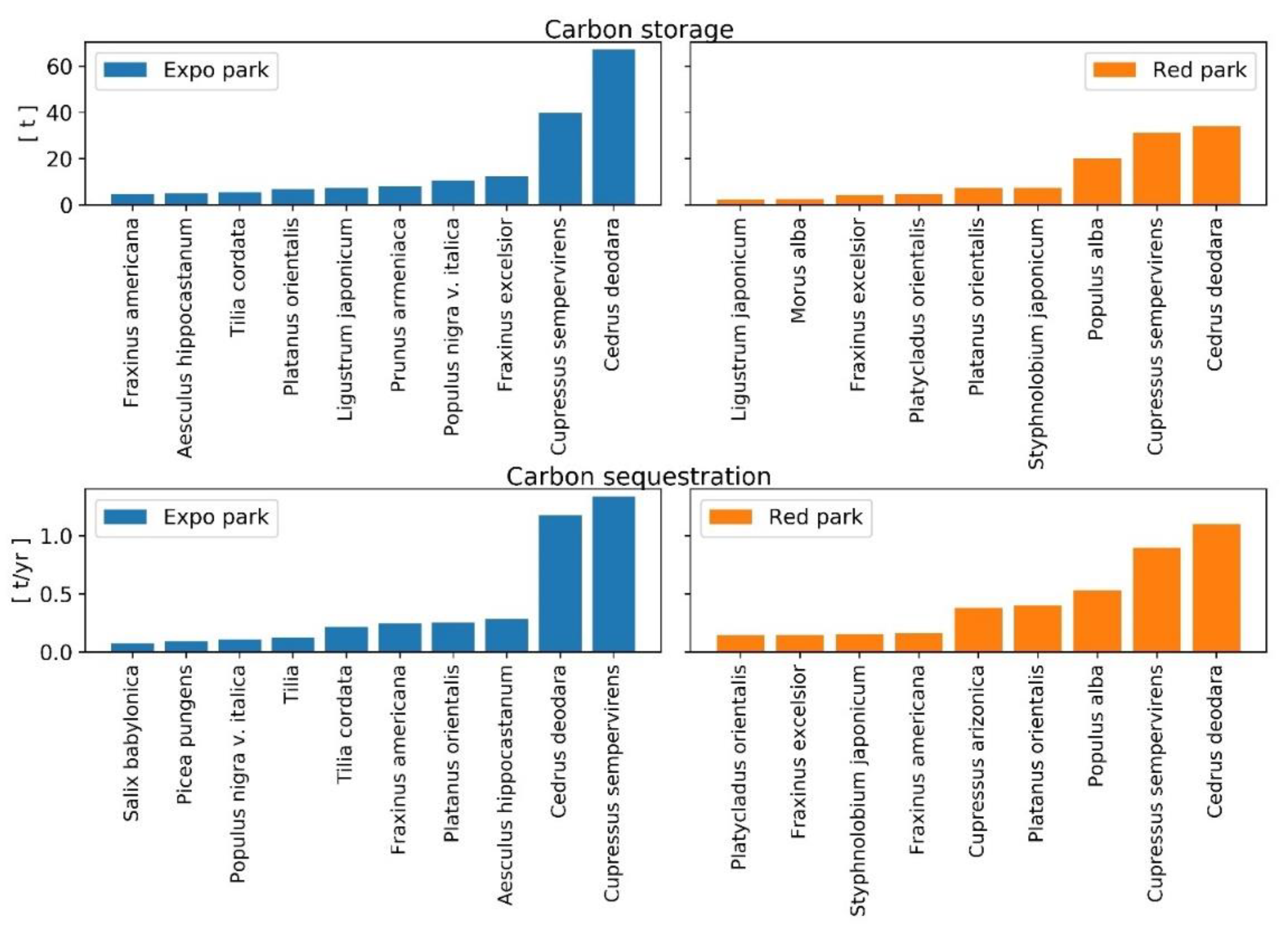
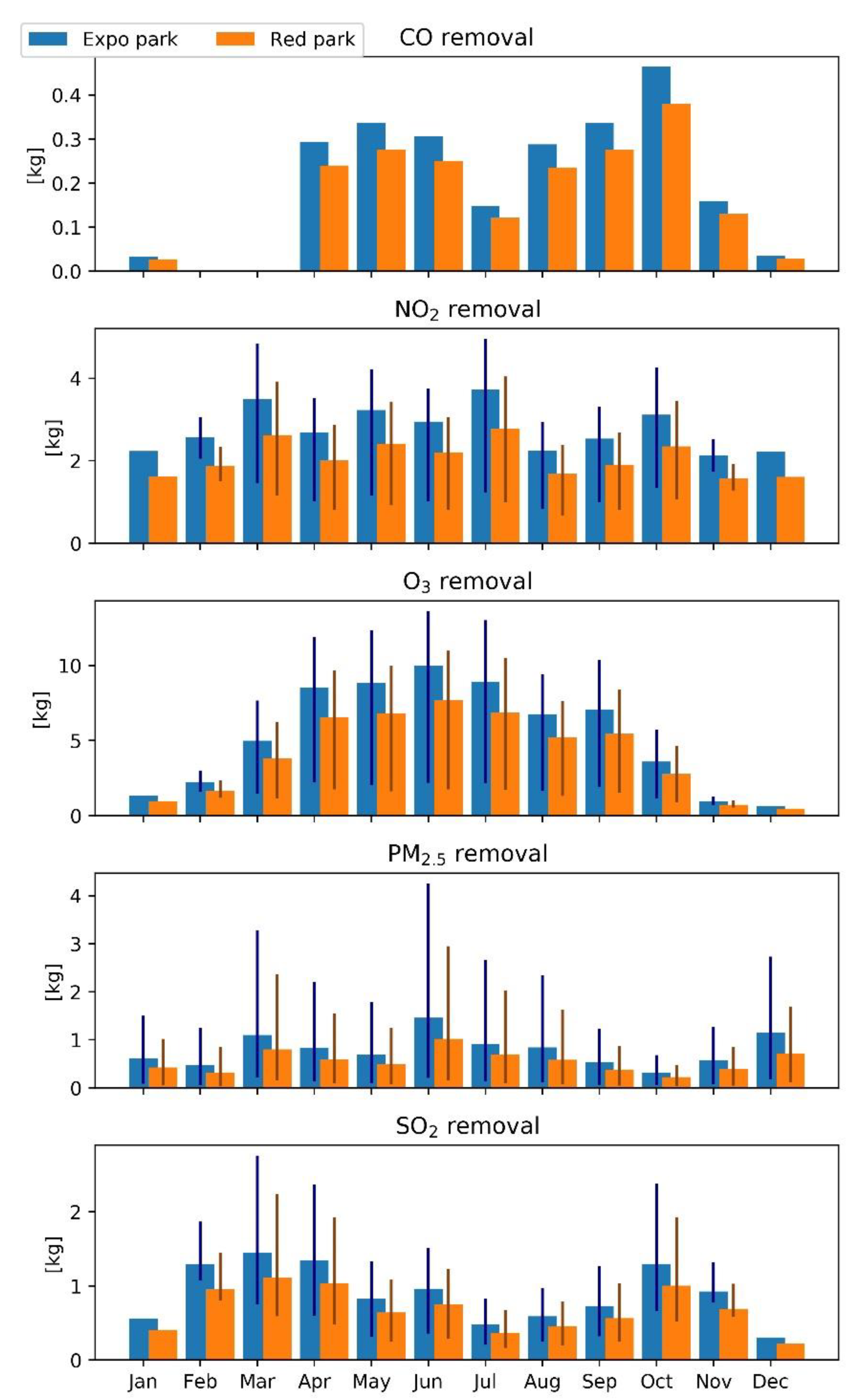
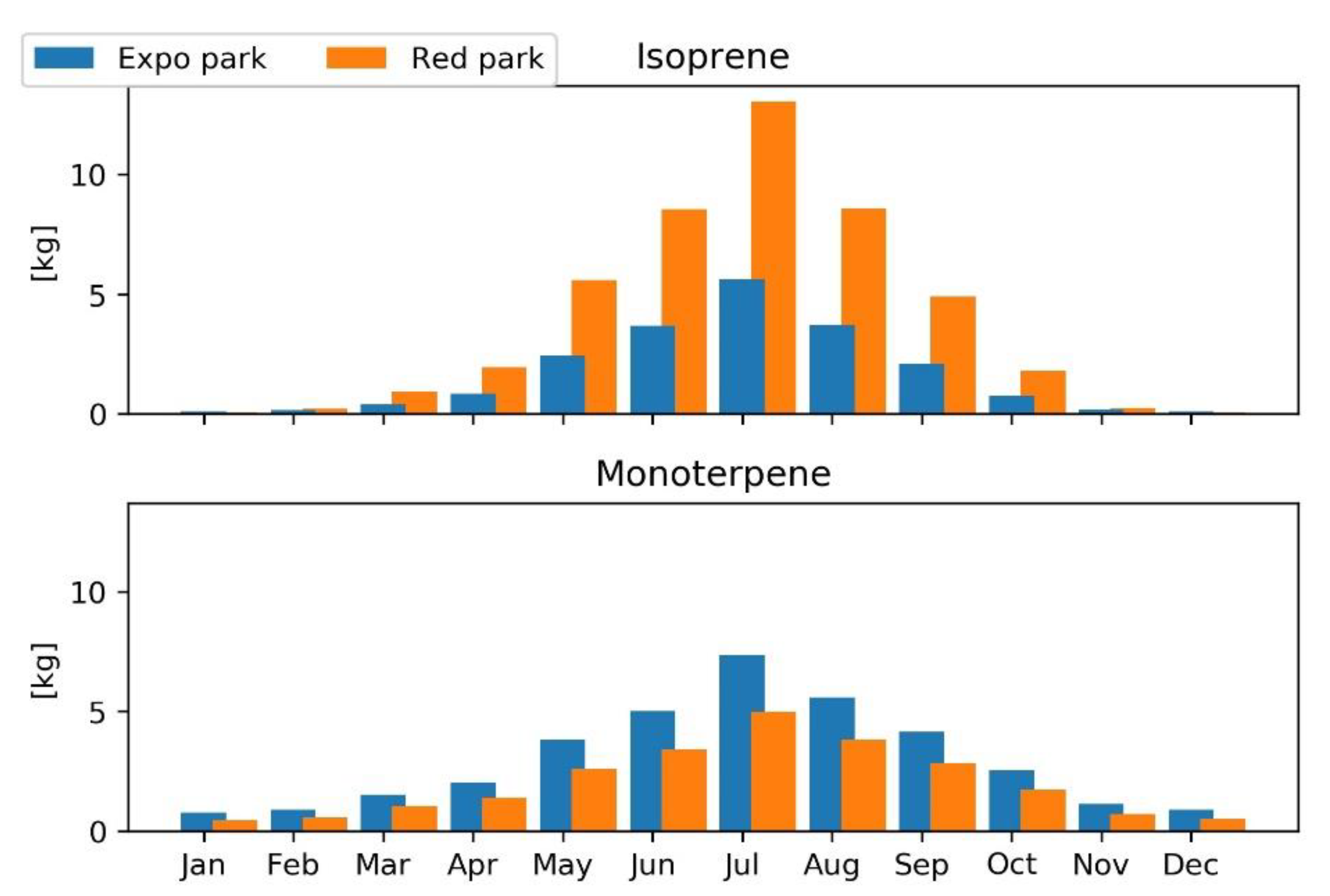

| Species | Number Trees (N°) | Canopy Cover (m2) | Leaf Area (m2) | Basal Area (m2) |
|---|---|---|---|---|
| Italian cypress (Cupressus sempervirens L.) | 125 | 2265.5 | 9496.2 | 6.3 |
| Oriental arborvitae (Platycladus orientalis (L.) Franco) | 79 | 406.5 | 1105.1 | 0.4 |
| Deodar cedar (Cedrus deodara (Roxb.) G. Don) | 61 | 2327.2 | 10,895.5 | 10.7 |
| European ash (Fraxinus excelsior L.) | 60 | 595.1 | 1749.2 | 1.1 |
| White ash (Fraxinus americana L.) | 41 | 475.4 | 1631.4 | 0.3 |
| Bigleaf linden (Tilia platyphyllos Scop.) | 32 | 306.5 | 1028.3 | 0.4 |
| Japanese pagoda tree (Styphnolobium japonicum (L.) Schott) | 30 | 844.5 | 2679.2 | 2.2 |
| Oriental planetree (Platanus orientalis L.) | 23 | 1462.4 | 8757.8 | 3.3 |
| White mulberry (Morus alba L.) | 17 | 612.4 | 2768.4 | 1.2 |
| White poplar (Populus alba L.) | 15 | 1478.1 | 6942.2 | 5.6 |
| TOT urban forest | 1030 | 14,625 | 55,917.6 | 32.7 |
| TOT dominant species | 483 | 10,773.6 | 47,053.3 | 31.5 |
| Relative number of dominant species (%) | 46.9 | 73.7 | 84.1 | 96.3 |
| Species | Number Trees (N°) | Canopy Cover (m2) | Leaf Area (m2) | Basal Area (m2) |
|---|---|---|---|---|
| Italian cypress (Cupressus sempervirens L.) | 116 | 3311.3 | 17,373.0 | 10.3 |
| Deodar cedar (Cedrus deodara (Roxb.) G. Don) | 58 | 3726.7 | 14,477.1 | 20.9 |
| Horse chestnut (Aesculus hippocastanum L.) | 54 | 1090.5 | 5883.6 | 1.3 |
| Japanese privet (Ligustrum japonicum Thunb.) | 47 | 909.3 | 3307.8 | 0.6 |
| Oriental planetree (Platanus orientalis L.) | 23 | 1142.3 | 6913.0 | 2.9 |
| Blue spruce (Picea pungens Engelm.) | 13 | 297.0 | 1930.8 | 0.9 |
| White ash (Fraxinus americana L.) | 12 | 616.5 | 4454.9 | 1.3 |
| White mulberry (Morus alba L.) | 11 | 399.9 | 1629.4 | 0.9 |
| Little leaf linden (Tilia cordata Mill.) | 11 | 621.4 | 3401.2 | 1.6 |
| European ash (Fraxinus excelsior L.) | 7 | 713.9 | 2983.2 | 3 |
| TOT urban forest | 694 | 17,866.4 | 79,992.2 | 53.6 |
| TOT dominant species | 352 | 12,828.8 | 62,354 | 43.7 |
| Relative number of dominant species (%) | 50.7 | 71.8 | 78.0 | 81.5 |
| Dominant Species Parks | Suggestion Tbilisi City Hall | Carbon Sequestration (g m−2 yr−1) | Avoided Runoff (l m−2 yr−1) | Pollution Removal (g m−2 yr−1) | Total VOCs (g m−2 yr−1) |
|---|---|---|---|---|---|
| Aesculus hippocastanum ** | R | 259.1 | 18.2 | 8.1 | 0.3 |
| Cedrus deodara * | P | 473.4 | 16.8 | 7.6 | 4 |
| Cupressus sempervirens ** | R | 403.1 | 17.7 | 7.8 | 4.1 |
| Fraxinus americana ** | 397.9 | 24.3 | 10.8 | 0 | |
| Fraxinus excelsior ** | P | 242.8 | 10.5 | 4.7 | 0 |
| Ligustrum japonicum ** | P | 10 | 12.3 | 5.4 | 12.9 |
| Morus alba * | 212.1 | 16.2 | 7.3 | 1.8 | |
| Picea pungens ** | R | 314.8 | 21.9 | 9.7 | 14.5 |
| Platanus orientalis ** | P | 219.4 | 20.4 | 7.6 | 4.5 |
| Platycladus orientalis * | 352.8 | 9.7 | 4.4 | 1.7 | |
| Styphnolobium japonicum * | P | 181.9 | 11.4 | 5.1 | 5.9 |
| Tilia cordata ** | 349.4 | 18.4 | 8.2 | 0 | |
| Tilia platyphyllos * | P | 248 | 12 | 5.4 | 0 |
Publisher’s Note: MDPI stays neutral with regard to jurisdictional claims in published maps and institutional affiliations. |
© 2021 by the authors. Licensee MDPI, Basel, Switzerland. This article is an open access article distributed under the terms and conditions of the Creative Commons Attribution (CC BY) license (https://creativecommons.org/licenses/by/4.0/).
Share and Cite
Alpaidze, L.; Pace, R. Ecosystem Services Provided by Urban Forests in the Southern Caucasus Region: A Modeling Study in Tbilisi, Georgia. Climate 2021, 9, 157. https://doi.org/10.3390/cli9110157
Alpaidze L, Pace R. Ecosystem Services Provided by Urban Forests in the Southern Caucasus Region: A Modeling Study in Tbilisi, Georgia. Climate. 2021; 9(11):157. https://doi.org/10.3390/cli9110157
Chicago/Turabian StyleAlpaidze, Levan, and Rocco Pace. 2021. "Ecosystem Services Provided by Urban Forests in the Southern Caucasus Region: A Modeling Study in Tbilisi, Georgia" Climate 9, no. 11: 157. https://doi.org/10.3390/cli9110157
APA StyleAlpaidze, L., & Pace, R. (2021). Ecosystem Services Provided by Urban Forests in the Southern Caucasus Region: A Modeling Study in Tbilisi, Georgia. Climate, 9(11), 157. https://doi.org/10.3390/cli9110157






